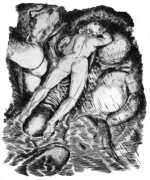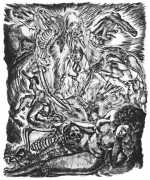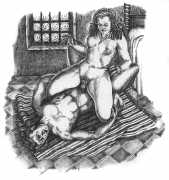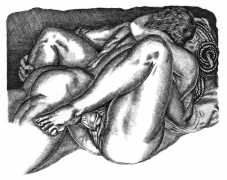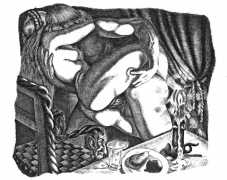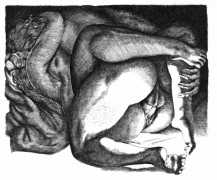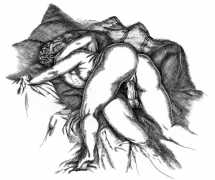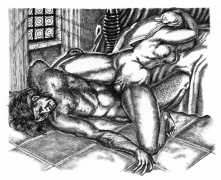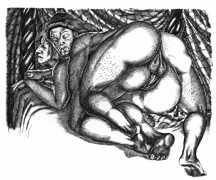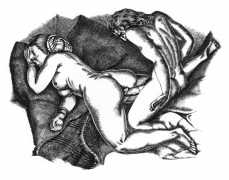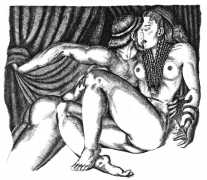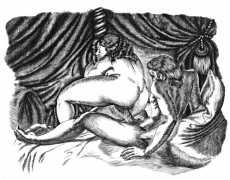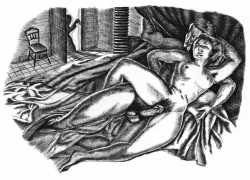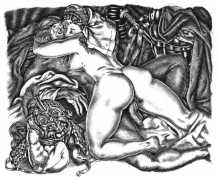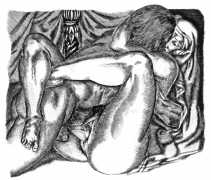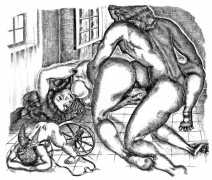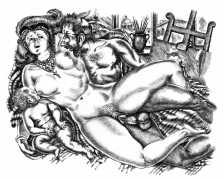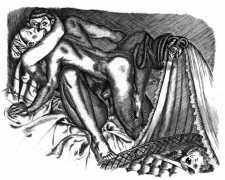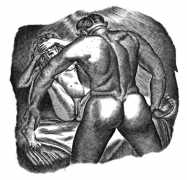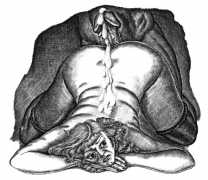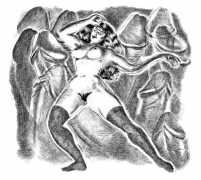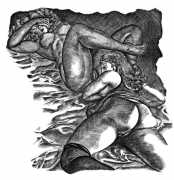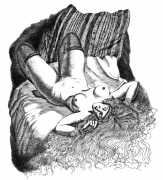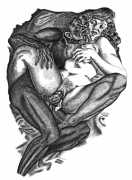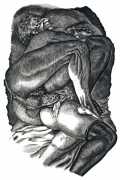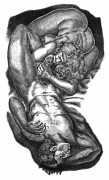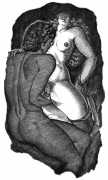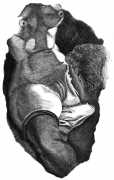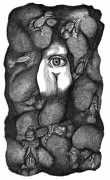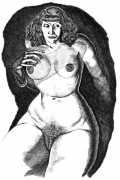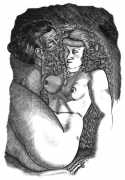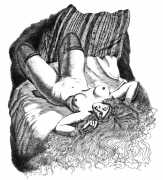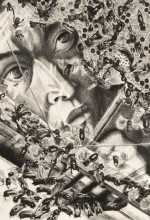
For such a talented, prolific and creative illustrator, it is remarkable that so little appears to be known about Tavy Notton. The son of French diplomat and scholar Camille Notton and his Thai wife Mae, he was born in Bangkok, but his early love appears to have been for Greece. Apart from some accomplished images of Greece dating from the 1930s, recollections of the Greek resistance during the second world war, and an invitation to a 1972 retrospective in a small French town, what we have to remember him by are several hundred fine black and white engravings created to illustrate books about natural history, architecture – and sex.
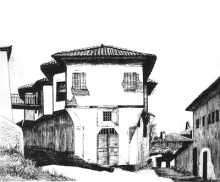
It seems likely that he spent several years in his twenties in the central Greek town of Trikala, as he produced illustrations for a couple of regional guides for that region in the 1930s. We know that during the German occupation of Greece Tavy Notton was active in the Greek resistance, as McMaster University in Canada holds an archive of an exhibition of his drawings and writings from 1941 to 1944, with captions in French suggesting that they were used in France to highlight the sufferings of that country during those dark times. As both a witness and a participant in the country’s suffering, he shared his experiences in words and pictures, writing ‘The famine – I am starving, you are starving, we are all suffering from the famine, abominable living skeletons undulating like withering plants, abominable tearful ghosts, whirling in my memory, I want to draw you. Yes! I remember. I remember. My pencil squeaks furiously on the paper, delivering my visions of pools of black blood, of my nightmares, of my fear. Finally my thoughts are visible; these nightmares have been taken away from me.’
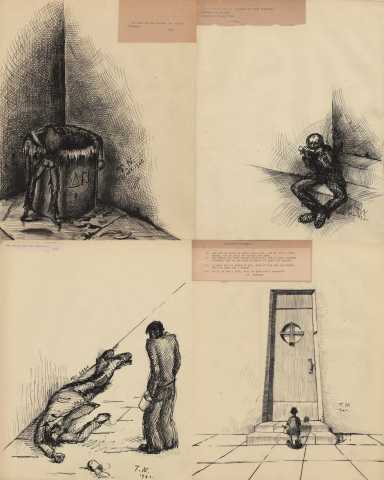
The next we know of Tavy Notton is that he was in France towards the end of the war, probably in or near Paris, and between 1943 and 1949 produced powerful and highly original engravings for three major erotic texts – Rimbaud’s homoerotic poems Les stupra, Aretino’s Sonnets luxurieux, and A une courtesane, supposedly by Baudelaire but actually by master-eroticist Pierre Durand. All three were produced in small limited editions ‘at the expense of a group of collectors’, so we can assume that Notton somehow came to know a few rich Parisians who knew of and appreciated his skills and his interest in erotic illustration. It is interesting to imagine why it was in this short turbulent period that he produced such powerful, almost shocking, erotic imagery; it was surely informed by personal experience, and many of his complex compositions must have been based on drawings from life.
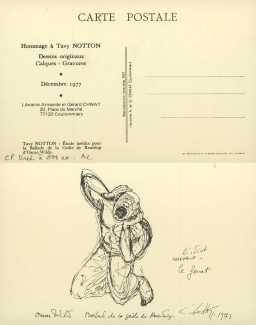 The early 1950s saw Notton producing illustrations for Tagore, Oscar Wilde, and an appreciation of Philippe Pétain, wartime Chief of State of Vichy France, and after that he concentrated exclusively on wonderful illustrations of wildlife – insects, bees, flowers, trees. Although we do not have dates, we know that between the wars he was married three times, first to Simone Delalande, then to the translator Andrée Joly (with whom he had a daughter), and lastly to the Greek engraver and illustrator Léla Pascali.
The early 1950s saw Notton producing illustrations for Tagore, Oscar Wilde, and an appreciation of Philippe Pétain, wartime Chief of State of Vichy France, and after that he concentrated exclusively on wonderful illustrations of wildlife – insects, bees, flowers, trees. Although we do not have dates, we know that between the wars he was married three times, first to Simone Delalande, then to the translator Andrée Joly (with whom he had a daughter), and lastly to the Greek engraver and illustrator Léla Pascali.
The last we know of Tavy Notton is that in 1972 a small gallery in Coulommiers, east of Paris, held a retrospective of his work, so we can maybe assume that Armande and Gérard Chwat were friends and promoters of his work. Notton’s final years were spent in Tournan-en-Brie, a small town a few miles west of Coulommiers.
Here is a complete list of books illustrated by Tavy Notton
Les stupra: Sonnets, Arthur Rimbaud, Aux dépens d’un groupe de bibliophiles, Grenoble, 1943
Mon jardin qui s’est souvenu, Charles Maurras, Tartas, Paris, 1948
Sonnets luxurieux, Pietro Aretino, Aux dépens de quelques amateurs, Paris, 1948
Chantefable de Murielle et d’Alain, André Berry, Lefebre, Paris, 1949
A une courtisane, Charles Baudelaire, Aux dépens de quelques amateurs, Paris, 1949
Les nourritures terrestres, André Gide, Vialetay, Paris, 1950
Jarres de Biot, Charles Maurras, Tartas, Paris, 1951
L’offrande lyrique, Rabindranath Tagore, Lubineau, Paris, 1951
Ballade de la Geole de Reading, Oscar Wilde, l’Odeon, Paris, 1951
En attendant Douaumont: Hommage au Maréchal Pétain, Maréchal de France, Tartas, Paris, 1952
Vie et moeurs des insectes, J.H. Fabre, l’Odeon, Paris, 1953
La vie des abeilles, Maeterlinck, Maurice, Au dépens d’amateur, Paris, 1954
Histoires naturelles, Jules Renard, l’Odeon, Paris, 1955
L’intelligence des fleurs, Maurice Maeterlinck, Reflet, Paris, 1955
Les chants du printemps, Georges-Louis Leclerc, Comte de Buffon, Aux dépens de l’artiste, Bourg-la-Reine, 1957
Les nouvelles nourritures, André Gide, Aux dépens de l’artiste, Paris, 1958
Le bestiaire du cortège d’Orphée, Guillaume Apollinaire, Aux dépens de l’artiste, Paris, 1962
Les chants de la forêt, Georges-Louis Leclerc, Comte de Buffon, Art Créations Bibliophilie, Genève, 1968
Los cantos del bosque, Georges-Louis Leclerc, Comte de Buffon, Ediciones Velazquez, Madrid, 1973
Los cantos de las soledades, Georges-Louis Leclerc, Comte de Buffon, Ediciones Velazquez, Madrid, 1976
Les chants des solitudes, Georges-Louis Leclerc, Comte de Buffon, Editions d’Art les Heures Claires, Paris, 1977




